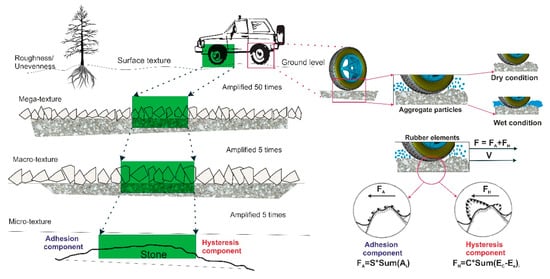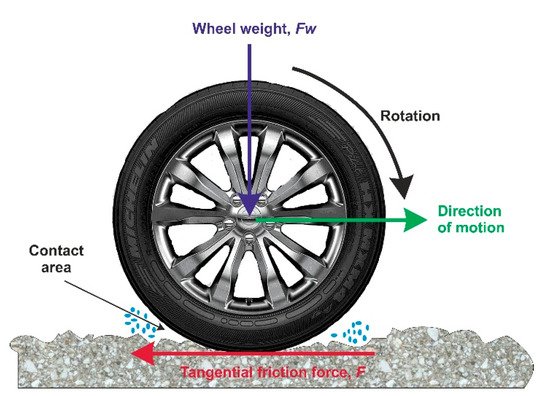Safe roads are essential to ensure the reliable movement of goods and people within the transport system. Multiple factors influence road collisions, which are usually grouped into three different categories, namely features related to drivers (e.g., stopping distance, driver skills and behavior of drivers, and vehicle speed), features related to the vehicle (e.g., tire and loading characteristics, vehicle design, and brake performance) and aspects corresponding to the roadway conditions (e.g., roadway geometry, traffic control measurement systems, and pavement conditions)
[1]. Nevertheless, a remarkable relationship between accident rates and such aspects of pavement surfaces as friction and pavement texture has been investigated in previous studies
[2][3][4][2,3,4]. The number of crashes was linked to the friction values of the road surface; a higher friction value was concluded, primarily based on empirical data, to decrease the number of accidents, particularly in dry conditions,
[5]. Poor surfaces of pavements with low skid resistance, inadequate visibility due to the spray used in wet conditions, and insufficient friction between vehicle tires and the surface of the pavement may lead to uncontrolled skidding and cause severe traffic crashes within the transportation system
[6]. Moreover, over 1.35 million people die and between 20 and 50 million are injured each year from different causes of road traffic crashes around the world according to the World Health Organization (WHO) and the authors of
[7][8][9][7,8,9]. On the other hand, in Europe, around 23,400 persons die each year in road accidents: 45% of the fatalities are passenger car drivers or passengers, and 21% are pedestrians, according to the statistics provided in
[2]. Traffic management studies indicate that 20% of traffic crashes are due to wet-weather conditions, which decrease the frictional resistance of the pavement surface
[10][11][10,11]. The frictional resistance of the pavement surface is considered to be a fundamental feature of the driving task, which ensures the safe maneuvering of vehicles in both the longitudinal and transversal directions
[12]. Another definition of skid resistance is the force generated when a tire is prevented from sliding in a circular manner on the pavement surface
[13][14][13,14]. It is a crucial parameter among the characteristics of the pavement surface, and significantly influences the efficiency of the roadway traffic system. Pavement assessment is essential to provide valuable information related to friction value and can be considered as a supporting tool to deliver appropriate maintenance and repair procedures to ensure a safe roadway system in all weather conditions. Consequently, comprehensive knowledge of skid resistance prediction and pavement surface characteristics can lead, as a function of different roadway parameters, to a reliable traffic management system.
2. Factors Influencing Skid Resistance
Pavement friction is commonly defined as the force that resists the relative movements between a vehicle tire and the surface of the road pavement. Thus, skid resistance is generated due to the rolling or sliding of vehicle tires on the pavement surface
[5][15][5,20]. Various factors can, directly and indirectly, influence the changes occurring in the skid resistance of the surface pavement.
Table 1 shows a critical summary list of the main factors that affect the skid resistance of surface pavements.
Table 1. Factors affecting the pavement surface skid resistance (modified from
[12][15][12,20]), grouped into 6 categories.
| Road Surface Characteristics |
Traffic Conditions |
Vehicle Operations |
Road Users |
Tire Properties |
Environmental Conditions |
| 1. | Microtexture |
1. | Traffic load |
1. | Slip speed | (SP) as a function of: |
1. | Lack of knowledge about skid resistance reduction |
Tread design and conditions |
1. | Temperature | (°C) |
| 2. | Macrotexture |
2. Traffic density |
1.a. Vehicle speed, V |
2. Inattention |
Inflation pressure |
2. | Water content; |
| 3. | Material characteristics |
3. Congestion |
1.b. Slip ratio % (G) |
3. Applied conditions of road pavement due to extreme weather conditions |
Rubber configuration and rigidity |
2.a. Rainfall |
| 4. Megatexture |
|
1.c. Braking System |
4. | Stopping distance |
Footprint |
2.b. Condensation |
5. Roughness/
unevenness |
|
1.d. Vehicle age |
5. | Driving manoeuvre |
Tire load |
3. | Snow and ice/freezing conditions |
| 6. Geometric of pavements |
|
1.e. Capacity of engine |
5.a. Turning |
Tire temperature |
4. | Contamination |
| 6.a. Curves |
|
1.f. Suspension stability |
5.b. Overtaking |
|
4.a. Sand/dust |
| 6.b. Slopes |
|
1.g. Vehicle load |
|
|
4.b. Salt |
| 7. Temperature (°C) |
|
1.h. Electronic stability control |
|
|
4.c. Dirt |
| |
|
|
|
|
d. Mud |
| |
|
|
|
|
4.e. Organic materials |
| |
|
|
|
|
4.f. Organic debris |
| |
|
|
|
|
4.g. Rubber particles |
| |
|
|
|
|
4.h. Wind |






